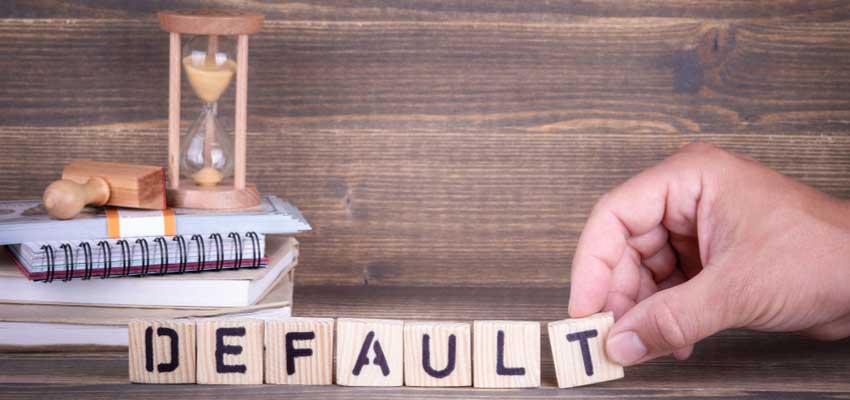Student loan default generally occurs on your student loans when you do not make a scheduled payment on your student loan for a period of at least 270 days. This default status will be displayed on your credit report and will make it difficult to take out any loans in the future. In this article, we will explain all the dangers of being in a defaulted student loan, as well as what the best options are to get out of default.
Dangers of a Student Loan Default
Having a student loan default can be a serious issue for a multitude of reasons. Firstly, it will negatively impact your credit which will make trying to borrow money very difficult in your future. You will have a note on your credit report that your loans are in default. Once your defaulted student loan is paid off, your credit report will reflect that the loan was paid off but will still inform any new lenders that you were once in default on that loan. This notation can stay on your credit for years.
1. Debt Collections
Falling into default on your federal student loans will also cause your loans to be sold to a collections agency. Once this happens, you will begin to receive many phone calls from the debt collector attempting to collect payments. Along with the harassing phone calls will come additional collection fees added onto your loan balance. The collection agencies are allowed to charge reasonable fees as a commission for their services. This can cause a lot of confusion for the borrower who if paying the collections agency, wrongly believes they are paying off their loans but may only be paying the fees without their student loan balance being paid down. In fact, it’s not uncommon for loan balances to increase while a borrower is paying a collections agency. If the accumulating interest on the loan and the collection fees combined are larger than the monthly amount being paid to collections, the loan balance will increase.
2. Federal Student Loan Borrowing Limitations
While in default on your student loans you lose all eligibility for new federal aid. This can present a very large problem for borrowers who have taken out loans to obtain a degree, and are unable to obtain this degree due to federal aid borrowing limitations. The borrower is then stuck with the student loan debt, but without the ability to finish obtaining the degree and a better paying job.
3. Lost eligibility for deferments and forbearance
Default loans lose eligibility for deferments and forbearance. Again, this presents a very dangerous predicament for the borrower who is typically only faced with the option of paying back their loans during this financial difficulty. Deferments and forbearances are designed to allow people some breathing room on their loans while they are having these financial difficulties. The reality is that many borrowers are not applying for these benefit programs while they are eligible, but rather once the collection calls have started and the eligibility for deferments are no longer available.
4. Wage Garnishment
One of the most frustrating issues when falling into default on your Federal Student Loans is that the Department of Education can have a wage garnishment order placed on you until the loans are paid off. A wage garnishment is a deduction directly off your paycheck that your employer must withhold from you. A garnishment order can be as high as 15% of your paycheck. Once an active wage garnishment order has been put on your account, your options become very limited. You can no longer consolidate to get out of default, and your lender will not lift the garnishment unless you enter into a rehabilitation program and make satisfactory payments to get your loan back in good standing.
5. Tax Offset
Coinciding with the wage garnishment, the department of education can and will refer your account to the IRS to offset any tax refund you may have by applying it to your loans. This means that any money you would normally have coming back to you in the form of a tax refund would instead by sent from the IRS directly to your student loan servicer to pay off the debt. Also very important is that the IRS can and will apply your spouses tax refund to your loans if you are married and filing jointly. Even if your spouse does not have student loans, and is not a co-signor on the loans.
Estimated 15 minute phone call
Fixing Your Student Loan Default
1. Rehabilitation
Getting your student loans out of default will require the borrower to be proactive and take action to get back into good standing. One option that’s available is a rehabilitation program. A rehabilitation of the loan is a 9-month program where the borrower makes agreed upon payments with the lender, and after all 9 payments are made on time, the default status is removed from the loan. The payment in the rehabilitation should be calculated the same with the Income Based Payment is calculated. If the borrower fails to make one payment, the rehabilitation would need to be restarted from the beginning. There are some positives and negatives in regards to loan rehabilitation that the borrower should understand prior to starting the rehabilitation.
2. Consolidation
Another option is to consolidate your loan into the William D. Ford Direct Loan program. What happens in this program is that your federal defaulted student loans are all paid off and consolidated into one new loan, often times with a new servicing institution. You would have one brand new loan that’s in good standing, with a weighted average interest rate of your old loans. When consolidating you are also able to choose from a selection of repayment plan options, some which can offer payments as low as $0.00 per month. This payment actually counts as a payment, unlike a deferment or forbearance which simply pauses the loan. Often people can have $0.00 monthly payments for years, and any unpaid balance remaining on the loan is forgiven after 20-25 years. There are other student loan forgiveness benefits as well. Much like the rehabilitation program, there are positives and negatives with the consolidation as well that the borrower should fully understand prior to going through the consolidation process.
3. Pay off The Loan in Full
Another option to fix a student loan default is to pay off the loan balance in full. While this isn’t usually an option for most people (or they wouldn’t be in default in the first place), it can be an option if you find someone that is willing to co-sign a new private student loan for you. If you have a friend or relative with a high credit score that’s willing to help you, there are many private student loan refinancing companies where you could refinance the loan to pay off your federal loans.



